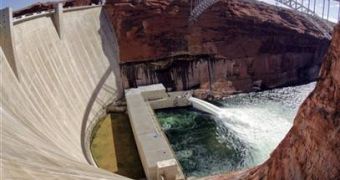The Glen Canyon Dam situated in northern Arizona, on the course of Colorado River flowing through the Grand Canyon, is one of the biggest artificial water accumulations, with the role of generating electric energy and supplying the population with precious water during severe droughts which may eventually hit the surrounding areas from time to time. On Wednesday, the Federal Government decided to flood the Grand Canyon with water for three days, in order to restore the ecosystem living at the base of the Glen Canyon Dam.
Two arcs of water from the base of the dam deliver up to 1,134,000 liters of water every second into the Canyon, enough to fill the volume occupied by the Empire State Building in less than 20 minutes. Secretary of Interior Dirk Kemthorne argues that the process has occurred naturally for millions of years, but with the building of the dam nearly 44 years ago people have restricted the water flow, thus interfering with the ecosystem living in the Canyon.
Similar actions have been previously executed, first in 1996 and then in 2004, in the hope that they would restore the natural cycle of the river. Though the damn was completed in 1964, the water flow of the Colorado River has been restricted ever since 1963. Usually, the water of the river was warm and muddy, but now the situation has changed dramatically to a cool and clear water, as the sediments the river is carrying are being blocked upstream by the dam.
As a result, several species of fish are on their way to extinction unless something is done. The release of water during the three days will exceed five times the debit of the water flowing through the Grand Canyon during normal operation.
In the outcome of the flood, scientists will conduct a series of experiments to establish whether or not the action has any effect on the environment, and how the increase of water debit affects the aquatic food chain. In the spring of 1996, the US government decided to artificially flood the dam, bypassing the dam's hydroelectric generators and dumping the water downstream instead, without harnessing its power. During the second artificial flood in 2004, scientists had the opportunity to study the relation between the sediments brought by the river, in relation to the environment, and realized that with all the sediment being blocked by the dam, downstream locations presented deep erosion patterns.
As you can see, this artificial flood does not only have the role of helping the indigenous species to recover, but also to recreate the sandy banks of the canyon. Upon studying the effects of the latest flood, scientists will determine whether or not future floods will be conducted downstream the Glen Canyon Dam.
On the other hand, critics say that in fact the set of artificial floods would not help very much, further delaying the long-term changes and endangering the 'health' of the canyon. They propose that the dam should be modified so that periodical floods are conducted, mimicking nature.

 14 DAY TRIAL //
14 DAY TRIAL //